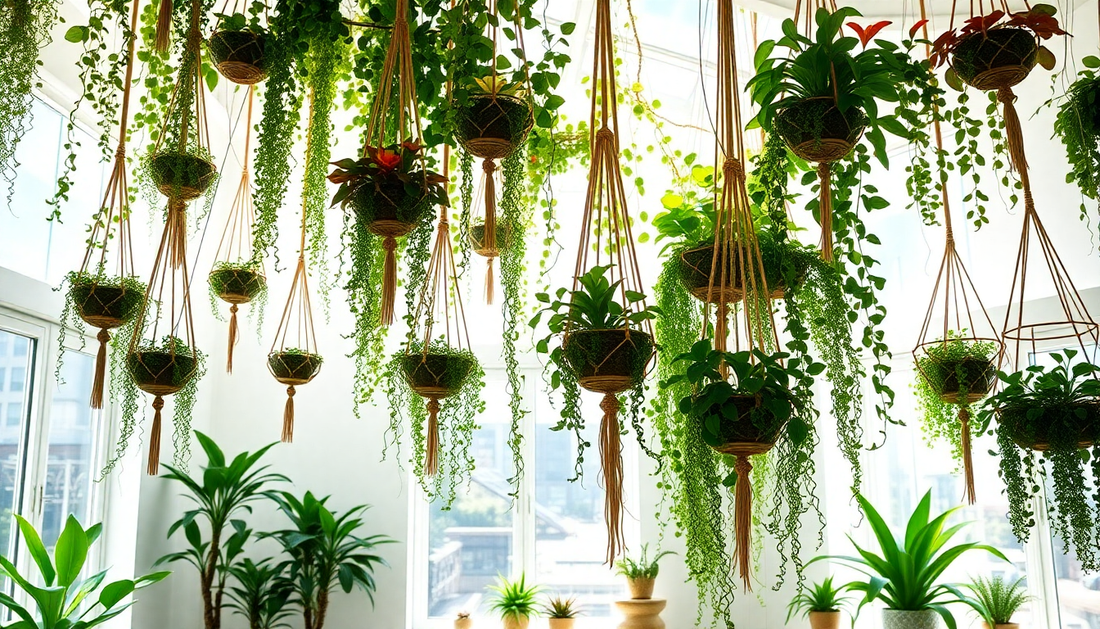
Create a Stunning DIY Indoor Hanging Garden
Share
Are you looking to add a touch of greenery and life to your indoor space? Look no further than a DIY indoor hanging garden! Not only do hanging plants add visual interest and a natural element to any room, but they can also help purify the air and boost your mood.
In this comprehensive guide, we'll walk you through the steps to create your own stunning indoor hanging garden. Whether you're a seasoned plant parent or a complete beginner, you'll find all the tips and tricks you need to cultivate a thriving oasis right in your own home.
Choosing the Right Plants
The first step in building your indoor hanging garden is selecting the perfect plants. When it comes to hanging plants, you'll want to choose varieties that are lightweight, trailing, and able to thrive in the conditions of your indoor space.
Some of the best options for indoor hanging gardens include:
Succulents
Succulents like string of pearls, string of hearts, and trailing jade are low-maintenance and add a whimsical, modern touch to any hanging display. They require infrequent watering and can tolerate a range of light conditions.
Ivy
Classic English ivy and Swedish ivy are classic choices for hanging baskets. They trail beautifully and can help purify the air in your home.
Philodendrons
Philodendrons come in a variety of shapes and sizes, from the heart-shaped leaves of the Brasil philodendron to the long, trailing vines of the heartleaf philodendron. They're easy to care for and add a lush, tropical vibe.
Pothos
Pothos plants are some of the most popular and resilient hanging plants. With their cascading, variegated leaves, they're a great option for beginners and experienced plant parents alike.
When selecting your plants, be sure to choose a mix of textures, colors, and growth habits to create a visually interesting display. You'll also want to consider the light levels in the room where your hanging garden will be placed and choose plants accordingly.
Choosing the Right Containers
Once you've picked out your plants, it's time to choose the perfect containers for your indoor hanging garden. There are a few key factors to consider:
Material
Hanging baskets come in a variety of materials, including wicker, macrame, metal, and even terracotta. Consider the overall aesthetic you're going for and choose a material that complements your decor.
Size
Make sure to select containers that are appropriately sized for the plants you've chosen. As a general rule, the container should be about 2-3 inches wider than the root ball of the plant.
Drainage
Proper drainage is essential for the health of your hanging plants. Look for containers with built-in drainage holes or consider adding your own.
Hanging Mechanism
Decide how you want to hang your garden - from a ceiling hook, a plant stand, or a macrame hanger. Make sure the container you choose has the appropriate hardware for your hanging method.
Planting and Caring for Your Hanging Garden
Now that you've selected your plants and containers, it's time to get planting! Here's a step-by-step guide:
-
Prepare the Containers: Start by lining the bottom of your containers with a layer of gravel or small stones to improve drainage. Then, fill the containers with a well-draining potting mix specifically formulated for indoor plants.
-
Plant the Greenery: Gently remove your plants from their nursery pots and place them in the prepared containers. Be sure to leave a bit of space between each plant to allow for growth.
-
Water Wisely: Hanging plants tend to dry out more quickly than their ground-dwelling counterparts, so be sure to check the soil regularly and water when the top inch or two becomes dry. Avoid letting the soil become completely saturated.
-
Provide Proper Lighting: Most of the plants recommended for indoor hanging gardens prefer bright, indirect light. Position your hanging garden in a spot that receives several hours of sunlight each day, but avoid direct, harsh sunlight which can scorch the leaves.
-
Fertilize Regularly: To keep your hanging plants thriving, feed them with a balanced, water-soluble fertilizer every 2-3 weeks during the growing season.
-
Prune and Maintain: Regularly prune any dead or damaged leaves or stems to encourage healthy growth and maintain the aesthetic of your hanging garden.
With the right plants, containers, and care, your DIY indoor hanging garden will quickly become the focal point of any room. Not only will it add a touch of natural beauty, but it can also help purify the air and boost your mood.
Styling Your Hanging Garden
Once your plants are all set up, it's time to get creative with the styling! Here are some tips to make your indoor hanging garden look its best:
Vary the Heights
Hang your baskets at different levels to create visual interest and depth. You can use plant stands, shelves, or even macrame hangers to achieve this.
Mix and Match Textures
Combine plants with different leaf shapes, sizes, and growth habits to add visual interest. Pair trailing vines with upright, bushy plants for a lush, layered look.
Incorporate Accent Pieces
Add decorative elements like ceramic pots, driftwood, or even small sculptures to complement the natural beauty of your hanging garden.
Lighting is Key
Strategically place your hanging garden near a window or under a light fixture to highlight the plants and create a cozy, inviting atmosphere.
Rotate and Refresh
Regularly rotate your hanging baskets to ensure even growth and replace any plants that become overgrown or unhealthy to keep your garden looking its best.
With a little creativity and care, your DIY indoor hanging garden can become a stunning, low-maintenance addition to your home. So why not get started on your own lush, green oasis today?
